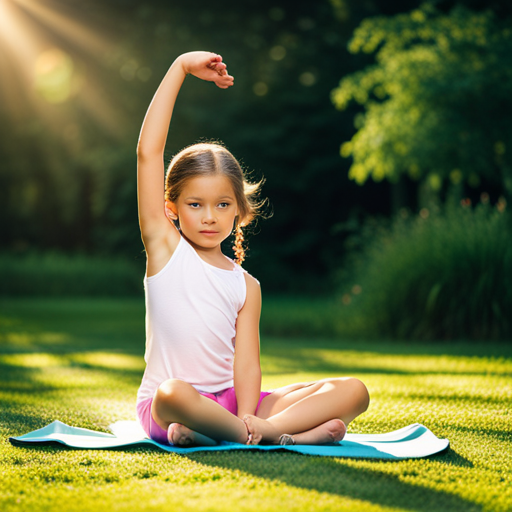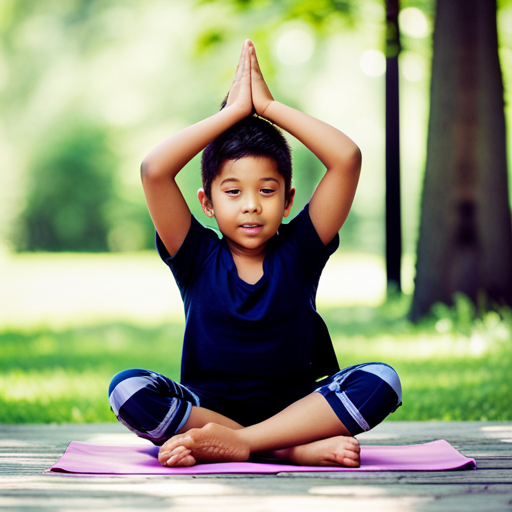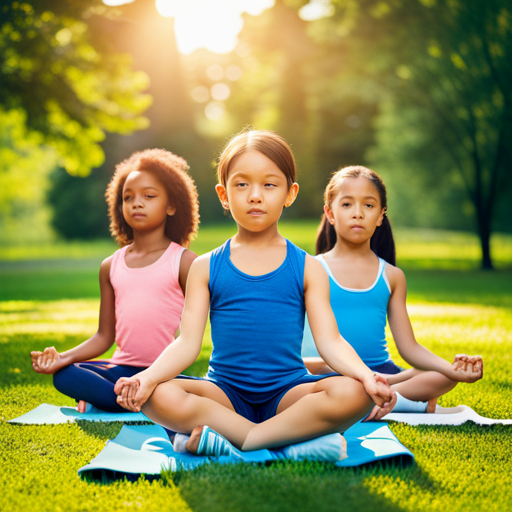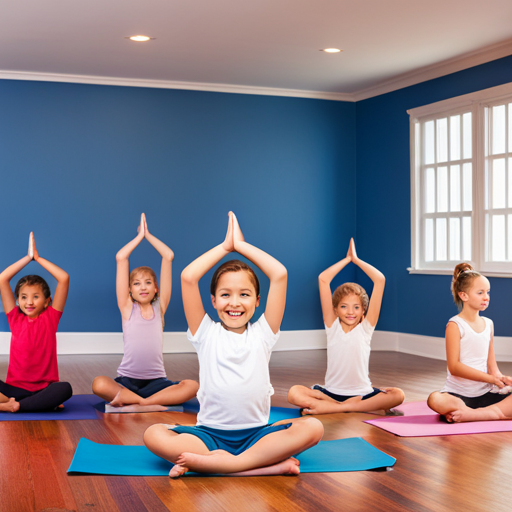"Cherishing Little Steps - A Haven for Baby and Family Journeys"
Child-Friendly Yoga and Mindfulness
Are you ready to embark on a journey of self-discovery and inner peace with your little one? They say, ‘A child’s mind is like a sponge,’ and child-friendly yoga and mindfulness are here to help them soak up all the goodness life has to offer.
In this intimate practice, you and your child will explore the power of breath, movement, and mindfulness together. Through playful yoga poses and calming mindfulness exercises, you will enhance their focus, reduce their stress, and improve their physical fitness.
But it doesn’t stop there! Child-friendly yoga and mindfulness also cultivate self-awareness, empathy, and social skills, promoting better sleep and relaxation.
So, let’s roll out the mat and dive into this transformative journey together!
Key Takeaways
- Child-friendly yoga and mindfulness develop physical strength and flexibility while cultivating mindfulness and emotional well-being.
- Child-friendly yoga and mindfulness enhance focus and concentration by calming the mind, improving focus and centering, enhancing memory, and training the mind to stay present and focused.
- Child-friendly yoga and mindfulness reduce stress and anxiety by alleviating stress and anxiety, relaxing the body and calming the mind through deep breathing exercises and guided meditations, bringing attention back to the present moment, and reducing anxious thoughts.
- Child-friendly yoga improves physical fitness and flexibility by making exercise fun and enjoyable, improving balance and stability, engaging all muscles and increasing strength, and enhancing flexibility and range of motion.
- Child-friendly yoga and mindfulness cultivate self-awareness and empathy by promoting self-awareness and connection with breath, developing empathy and social skills through mindfulness exercises, fostering inner peace and calmness by connecting with breath, teaching children to manage emotions and navigate challenges, and enhancing self-confidence and self-expression.
The Benefits of Child-Friendly Yoga
Child-friendly yoga offers numerous benefits for children, allowing them to develop physical strength and flexibility while also cultivating mindfulness and emotional well-being. It’s like a magical potion that boosts their cognitive function and enhances their emotional regulation.
Picture this: your little one, moving and stretching their body, their imagination taking flight like a colorful butterfly. Through child-friendly yoga, they engage in playful poses, learning to balance, bend, and twist. And guess what? It’s not just fun and games – it’s actually good for their brain!
When kids practice yoga, they activate their brain cells, improving cognitive function. It’s like a secret workout for their minds! As they flow from one pose to another, their concentration and focus sharpen, helping them excel academically. When faced with challenges, they become better problem-solvers, finding creative solutions. It’s like they’ve unlocked a superhero power!
But that’s not all. Child-friendly yoga also works wonders when it comes to enhancing emotional regulation. In yoga class, children learn to connect with their breath, finding inner peace and calmness. They discover the power of deep breathing, a tool they can use to manage their emotions. So, the next time they feel angry or overwhelmed, they can take a deep breath and let it all go. It’s like having a superpower that helps them navigate the ups and downs of life.
Child-friendly yoga is truly a gift, offering children the opportunity to improve their cognitive function and enhance their emotional regulation. So, roll out that yoga mat and let the adventure begin!
Enhancing Focus and Concentration

Practice yoga regularly to improve your focus and concentration.
Yoga isn’t just about physical exercise; it also trains your mind to stay present and focused.
By incorporating yoga into your routine, you can enhance your memory and improve your academic performance.
Here are three ways yoga can help you boost your focus and concentration:
-
Mindful Breathing: Yoga teaches you to pay attention to your breath. Deep, mindful breathing helps calm your mind, reduce stress, and increase your ability to concentrate.
-
Balance Poses: Balancing poses in yoga require focus and concentration. As you work on maintaining your balance, you also strengthen your ability to stay focused and centered in other areas of your life.
-
Meditation: Yoga often includes meditation, which helps quiet the mind and improve concentration. Regular meditation practice can enhance your memory and cognitive abilities, leading to better academic performance.
By practicing yoga and incorporating these techniques into your daily life, you can enhance your focus, improve your memory, and excel in your studies.
Reducing Stress and Anxiety
One effective way to alleviate stress and anxiety is by incorporating mindfulness techniques into your daily routine. Life can be full of challenges and it’s important to have tools to help you manage stress and reduce anxiety. Mindfulness provides a powerful way to do just that. By practicing mindfulness, you can learn to be present in the moment and cultivate a sense of calm and peace amidst the chaos.
Stress management is all about finding healthy ways to cope with the pressures of life. Mindfulness offers a variety of techniques that can help you do just that. From deep breathing exercises to guided meditations, there are many ways to incorporate mindfulness into your daily routine. These practices can help you relax your body, calm your mind, and reduce the harmful effects of stress on your overall well-being.
Anxiety reduction is another key benefit of mindfulness. When you’re feeling anxious, your mind is often racing with worries and fears about the future. Mindfulness helps to bring your attention back to the present moment, grounding you in the here and now. By focusing on your breath and observing your thoughts without judgment, you can create a sense of distance from your anxious thoughts and find a greater sense of peace and calm.
Incorporating mindfulness into your daily routine can have a profound impact on your stress levels and overall well-being. By taking the time to practice mindfulness, you’re giving yourself the gift of self-care and creating a foundation for a healthier, happier life. So why not give it a try? Start small, with just a few minutes of mindfulness each day, and gradually build up from there. You’ll be amazed at the difference it can make in your stress management and anxiety reduction.
Improving Physical Fitness and Flexibility

To enhance your physical fitness and flexibility, incorporating child-friendly yoga and mindfulness into your routine can greatly benefit you. Not only will it make exercise fun and enjoyable, but it will also help you improve your balance and increase your strength.
Here’s how child-friendly yoga and mindfulness can help you achieve these goals:
-
Improving Balance: Yoga poses require you to find stability and maintain balance. By practicing these poses regularly, you’ll strengthen your core muscles and improve your overall balance. Whether you’re standing on one leg in the tree pose or balancing on your hands in the downward dog pose, you’ll develop a strong sense of stability that will carry over into other physical activities.
-
Increasing Strength: Yoga is a full-body workout that engages all of your muscles. As you move through different poses, you’ll build strength in your arms, legs, and core. Whether you’re holding a plank pose or flowing through a series of sun salutations, you’ll notice your muscles getting stronger over time. Plus, the gentle resistance provided by your body weight in yoga poses helps to tone and sculpt your muscles.
-
Enhancing Flexibility: One of the key benefits of yoga is its ability to improve flexibility. As you stretch and move your body through different poses, you’ll gradually increase your range of motion. This increased flexibility not only helps to prevent injuries but also allows you to move more freely in your daily activities.
Incorporating child-friendly yoga and mindfulness into your routine is a playful and enjoyable way to improve your physical fitness and flexibility. So why not give it a try? Roll out your mat, breathe deeply, and let the benefits of yoga and mindfulness unfold.
Cultivating Mindfulness and Self-Awareness
To cultivate mindfulness and self-awareness, incorporate child-friendly yoga and mindfulness into your routine. Cultivating mindfulness involves developing a heightened sense of awareness and attention to the present moment. It’s all about being fully present and engaged in whatever you’re doing, whether it’s a yoga pose or simply taking a deep breath. By practicing child-friendly yoga and mindfulness, you can help your child develop these important skills from an early age.
One way to cultivate mindfulness is through guided breathing exercises. Encourage your child to take slow, deep breaths and notice the sensation of the breath entering and leaving their body. This simple practice can help them become more aware of their thoughts, feelings, and physical sensations.
Another way to foster self-awareness is through mindful movement. Child-friendly yoga poses can help your child become more attuned to their body and its capabilities. Encourage them to notice how each pose feels, both physically and emotionally. This can help them develop a greater sense of bodily awareness and a deeper connection to themselves.
Boosting Emotional Well-being

By incorporating child-friendly yoga and mindfulness into your routine, you can boost your child’s emotional well-being. It’s important to prioritize your child’s emotional health because it sets the foundation for their overall well-being.
Here are three ways child-friendly yoga and mindfulness can help boost your child’s emotional well-being:
-
Boosting Self Esteem: Yoga and mindfulness practices can help your child develop a positive self-image and enhance their self-esteem. Through these practices, they learn to appreciate their unique qualities and strengths, fostering a sense of self-worth and confidence.
-
Managing Emotions: Yoga and mindfulness provide tools for your child to better manage their emotions. Breathing exercises, meditation, and mindful movement help them develop self-regulation skills, allowing them to recognize and express their emotions in a healthy and constructive way.
-
Cultivating Resilience: Practicing yoga and mindfulness helps your child build resilience, which is crucial for navigating life’s challenges. By learning to stay present, focus on the present moment, and develop a positive mindset, they become better equipped to bounce back from adversity and setbacks.
Incorporating child-friendly yoga and mindfulness into your child’s routine can have a profound impact on their emotional well-being. It’s a wonderful way to support their overall development and help them thrive. So why not give it a try and see the positive impact it can have on your child’s life?
Developing Resilience and Coping Skills

Developing resilience and coping skills is essential for your child’s emotional well-being and can be fostered through child-friendly yoga and mindfulness practices. By building emotional intelligence and teaching problem-solving skills, your child will be equipped with the tools needed to navigate life’s challenges with confidence and grace.
Let’s take a closer look at how child-friendly yoga and mindfulness can help your child develop resilience and coping skills:
| Yoga Poses | Benefits |
|---|---|
| Tree Pose | Builds balance and stability, teaching your child to stand strong even when things get tough. |
| Child’s Pose | Encourages relaxation and self-soothing, helping your child find a safe space within themselves during times of stress. |
| Warrior Pose | Enhances strength and focus, empowering your child to face adversity head-on and conquer their fears. |
| Downward Dog | Cultivates a sense of surrender and release, teaching your child the importance of letting go and moving forward with resilience. |
As your child engages in these yoga poses, they will not only strengthen their physical body but also their emotional resilience. Mindfulness practices, such as deep breathing exercises and guided visualization, can further enhance their ability to cope with difficult emotions and situations.
Fostering Social Skills and Empathy
Child-friendly yoga and mindfulness practices can play a crucial role in nurturing social skills and empathy in your child. By incorporating these practices into their daily routine, you can help foster emotional intelligence and build strong relationships.
Here’s how:
-
Mindful listening: Through yoga and mindfulness, your child can learn the art of active listening. By paying attention to their breath and body, they can also learn to tune in and listen to others with empathy and understanding.
-
Cooperation and teamwork: Yoga poses and partner exercises can teach your child the importance of working together and cooperating with others. They can learn to support and encourage their peers, fostering a sense of teamwork and camaraderie.
-
Cultivating kindness and compassion: Yoga and mindfulness can help your child develop a sense of empathy towards themselves and others. Through practices like loving-kindness meditation, they can learn to extend kindness and compassion to those around them, building strong and meaningful relationships.
Promoting Better Sleep and Relaxation
To promote better sleep and relaxation, incorporate child-friendly yoga and mindfulness practices into your child’s routine. Creating a bedtime ritual that includes calming activities can help your little one unwind and prepare for a peaceful slumber.
Begin by dimming the lights and creating a cozy environment that encourages relaxation. Encourage your child to engage in gentle stretching exercises, such as the cat-cow pose or the butterfly pose, to release any tension in their body. Incorporating deep breathing techniques, like the bunny breath or the balloon breath, can also help your child relax and let go of any worries from the day.
After the stretching and breathing exercises, guide your child through a mindfulness meditation. This can be as simple as focusing on their breath or visualizing a peaceful scene, like lying on a cloud or floating on a calm lake. Encourage them to let go of any thoughts or worries that may be keeping them awake.
By practicing these relaxation techniques regularly, your child will develop a sense of calm and tranquility that will promote better sleep.
Remember, children thrive on routine and consistency, so make sure to incorporate these practices into their nightly routine. With time and practice, your child will experience better sleep and wake up feeling refreshed and ready to tackle the day.
Introducing Yoga Poses and Sequences

Incorporate various yoga poses and sequences to engage your child in a fun and beneficial physical activity. Yoga for toddlers and yoga for teenagers can both be fun and accessible, allowing kids of all ages to reap the benefits of this ancient practice. Here are three yoga poses and sequences to get you started:
-
Downward Dog: Start on all fours, then lift your hips up towards the sky, forming an upside-down V shape with your body. This pose strengthens the arms and legs while stretching the back and hamstrings.
-
Tree Pose: Stand tall with your feet together, then lift one foot and place it on the inner thigh of the opposite leg. Find your balance and bring your hands together at your heart center. This pose improves balance and focus.
-
Sun Salutation: Begin in Mountain Pose, then reach your arms up overhead as you inhale. Exhale and fold forward, placing your hands on the ground. Step back into a plank position, then lower yourself down into a push-up. Finish by returning to Mountain Pose. This sequence warms up the body and energizes the mind.
Incorporating these poses and sequences into your child’s routine can help them develop strength, flexibility, and mindfulness. So grab a yoga mat and get ready to have some fun together!
Incorporating Mindfulness Exercises Into Daily Life
You can easily incorporate mindfulness exercises into your daily life by practicing simple techniques that promote relaxation and self-awareness. Mindfulness exercises aren’t just for teenagers or schools; they can benefit everyone, regardless of age or environment. So, why not give it a try?
One way to incorporate mindfulness into your daily routine is by starting your day with a few deep breaths. As you breathe in, feel your lungs fill with fresh air, and as you exhale, let go of any tension or stress. This simple practice can help you begin your day with a sense of calm and focus.
Another way to integrate mindfulness into your daily life is by taking short mindfulness breaks throughout the day. Set a reminder on your phone or computer to take a few minutes to pause, close your eyes, and check in with your body and mind. Notice any sensations, thoughts, or emotions that arise without judgment.
Incorporating mindfulness into schools is also becoming more popular, as educators recognize the benefits it can have on students’ well-being and academic performance. Teachers can start each class with a short mindfulness exercise, such as a breathing exercise or a guided meditation. This helps students to center themselves and be more present in the learning environment.
Frequently Asked Questions
How Can Child-Friendly Yoga and Mindfulness Benefit Children With Special Needs?
Child-friendly yoga and mindfulness can benefit special needs children by providing them with therapeutic techniques to improve their physical and mental well-being. These practices offer relaxation, focus, and self-regulation skills, promoting a sense of calm and empowerment.
Is It Safe for Children to Practice Yoga and Mindfulness on Their Own?
Is it safe for you to practice yoga and mindfulness on your own? Well, let’s consider the benefits: self-discovery, relaxation, and focus. But don’t forget the challenges and potential risks. Follow safety guidelines and listen to your body. You got this!
Can Child-Friendly Yoga and Mindfulness Help Improve Academic Performance?
Child-friendly yoga and mindfulness can improve academic performance in the long term. Mindfulness reduces stress and anxiety in children, allowing them to focus better on their studies. So, why not give it a try? You might see some incredible results!
How Can Parents Incorporate Yoga and Mindfulness Into Their Daily Routines With Their Children?
You can easily incorporate yoga and mindfulness into your daily routines with your children. It’s a great way to bond and reduce anxiety. Try simple poses and breathing exercises during playtime or bedtime.
Are There Any Age Restrictions for Child-Friendly Yoga and Mindfulness?
Age limitations for child-friendly yoga and mindfulness vary, but there are techniques suitable for all ages. It’s important to choose appropriate practices that align with your child’s developmental stage and abilities.
Conclusion
So why wait? Take a deep breath, roll out your mat, and dive into the wonderful world of child-friendly yoga and mindfulness!
It’s like a magical journey that enhances focus, reduces stress, improves physical fitness, cultivates mindfulness, fosters social skills, promotes better sleep, and introduces exciting yoga poses and mindfulness exercises.
It’s a treasure trove of benefits just waiting for you and your little ones to explore.
So come on, let’s stretch, breathe, and discover the joy of yoga together!
Namaste!



generic name for allergy pills antihistamine nasal spray canada alphabetical list of allergy medications
sleeping tablets prescribed by doctors cheap modafinil 100mg
order prednisone online cheap buy deltasone 5mg
over the counter medication that causes nausea zyloprim 100mg cheap
medications that can cause gerd order lamivudine sale
buy isotretinoin without prescription where to buy isotretinoin without a prescription cheap isotretinoin 40mg
generic amoxicillin 500mg order amoxil 500mg online cheap order amoxicillin 1000mg generic
purchase online sleeping tablets modafinil for sale online
purchase zithromax order zithromax 500mg without prescription azithromycin 500mg pill
neurontin 600mg uk gabapentin generic
azipro 250mg price azithromycin us buy azipro online
buy furosemide 40mg generic buy generic furosemide online
buy cheap omnacortil buy omnacortil 5mg online cheap buy prednisolone 40mg pill
amoxicillin 1000mg pills cheap amoxicillin sale purchase amoxicillin
monodox us generic vibra-tabs
buy ventolin 4mg generic albuterol sale albuterol tablet
augmentin 1000mg cheap augmentin generic
cheap generic levothyroxine order synthroid 75mcg buy synthroid pills for sale
order vardenafil 10mg generic buy levitra generic
zanaflex us zanaflex usa purchase tizanidine generic
serophene pills order clomid online buy clomid 100mg pills
prednisone pills order deltasone generic order prednisone 20mg generic
order accutane 10mg generic buy isotretinoin without prescription buy generic isotretinoin for sale
order generic semaglutide 14mg cheap semaglutide 14mg buy generic rybelsus for sale
cheap amoxil 1000mg amoxil 250mg cost buy generic amoxicillin
albuterol 2mg without prescription generic albuterol 4mg allergy drugs list
purchase azithromycin without prescription azithromycin 250mg pill order zithromax 500mg online
buy generic augmentin 625mg augmentin online purchase amoxiclav generic
prednisolone 10mg cheap cheap prednisolone order prednisolone
order synthroid 100mcg levoxyl for sale buy generic synthroid
buy gabapentin no prescription buy gabapentin pill neurontin pill
clomid price clomid cost purchase clomid for sale
furosemide ca furosemide 40mg without prescription buy generic furosemide over the counter
free shipping viagra buy viagra 50mg pill buy viagra 100mg online cheap
order doxycycline 200mg pills order doxycycline 200mg pill doxycycline 100mg price
online casino for real cash ladbrokes uk casino slots gambling
buy generic vardenafil purchase levitra pills purchase vardenafil sale
buy generic pregabalin over the counter lyrica pill pregabalin uk
plaquenil 400mg tablet purchase plaquenil sale buy plaquenil 400mg online
triamcinolone over the counter aristocort buy online generic triamcinolone 4mg
buy desloratadine medication clarinex price clarinex for sale online
tadalafil 10mg for sale order tadalafil 40mg generic order tadalafil 5mg generic
buy claritin medication loratadine 10mg tablet order claritin 10mg pills
cost cenforce 100mg order cenforce 100mg generic order cenforce generic
dapoxetine uk dapoxetine 60mg sale where can i buy cytotec
orlistat 120mg for sale orlistat 120mg generic diltiazem without prescription
cheap glucophage 500mg order metformin online cheap glycomet 1000mg uk
brand acyclovir 800mg allopurinol sale allopurinol online order
purchase amlodipine without prescription buy norvasc 5mg generic buy norvasc 5mg sale
buy rosuvastatin paypal ezetimibe buy online zetia 10mg for sale
oral lisinopril 10mg order lisinopril 5mg for sale lisinopril order online
order motilium 10mg generic motilium drug tetracycline 250mg pills
omeprazole 20mg cheap buy omeprazole 10mg order prilosec 10mg for sale
flexeril pills buy baclofen online ozobax online order
cheap lopressor generic lopressor 50mg metoprolol sale
order toradol 10mg without prescription buy gloperba generic colchicine 0.5mg drug
order tenormin 50mg for sale buy tenormin sale buy generic tenormin for sale